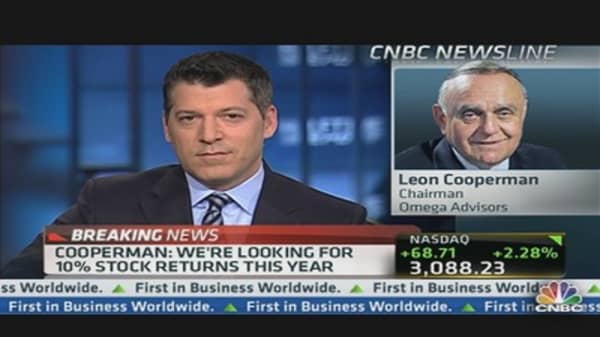"You need to see a little bit of a dip to buy into this (rally Wednesday). There's short-term upside. Looking six months down the road, I'm not so positive," LaRose said. "Sell in May and go away might prove quite true this year around."
The selling catalyst he sees is the sovereign debt issues in Europe cropping back up again. While liquidity efforts to boost the peripheral euro zone countries have helped stave off the crisis, the region continues to be in recession.
"The 800-pound gorilla in the room is the euro and what's going to happen there," he said. "The still have many unresolved issues that are going to become front-page headlines."
Careful of Other Cliffs
With tax issues off the table, Congress now will have to tackle spending cuts and the debt ceiling, which already has been breached.
Both issues will pose peril for investors—perhaps even more so than the fiscal cliff.
"It would be irresponsible to tell investors that we're going to be able to get through the debt ceiling crisis" unscathed, said Greg Valliere, chief political strategist at Potomac Research Group. "The debt ceiling crisis could be more ominous for the markets than the the fiscal cliff, aboslutely."
Health care specifically and defensive stocks broadly are susceptible to shocks from Washington turmoil and economic weakness this year, Valliere said.
"The tax changes are going to put a hurting on GDP for at least a quarter or two, and that's got to be a concern," he added. "If there's a huge rally, I would be inclined to sell it off. We're looking at a weak economy in the first and second quarters."
Keep it Simple
Dividend-paying stocks seem like a natural in times of uncertainty, but they underperformed in 2012.
While the Standard & Poor's 500 gained more than 13 percent, dividend stocks rose less than half that. A popular exchange-traded fund that tracks the group, the iShares Dow Jones Select Dividend Index fund, gained increased just 4.9 percent for the year.
With a series of cliff-beating special dividend issuances and a slow-growth economy ahead, dividends could be a weak sister again for a market that most everybody on Wall Street expects to post big full-year gains.
As an alternative, hedge fund manager Dennis Gartman suggests investors stick with the basics.
"We like simple things; the things that if dropped on your foot shall hurt," the author of The Gartman Letter said. "We like railroads and ball bearing manufacturers and steel and copper and iron ore and home builders and perhaps even ships and shippers."
Beware the Cushy Middle
A typical first year of the election cycle - U.S. President Barack Obama officially begins his second term Jan. 20 - would see "a good, but not great" year in which stocks would rise early and then again late, with a wobbly middle, according to Sam Stovall, chief equity strategist at S&P-Capital IQ.
"However, while this kind of annual encapsulation may be enlightening, and even a bit entertaining, it is meant to serve as a guide and not gospel," he said in an analysis. "As we enter 2013, we already know that this will be anything but a normal year."
Stovall proposed that further trading will provide "better entry levels" for investors than the current euphoria presents.
So while the post-cliff honeymoon surges on, investors should remember that the first trading day of the year is often positive, and there's much more yet to overcome.
"Given the cantankerous nature of the negotiations over the past 10 days it is now very possible that we will see another stand-off over those spending cuts and the debt ceiling that leads to a shutdown of the federal government by late February or early March," said Paul Ashworth, chief U.S. economist at Capital Economics. "Out of the frying pan, into the fire."





